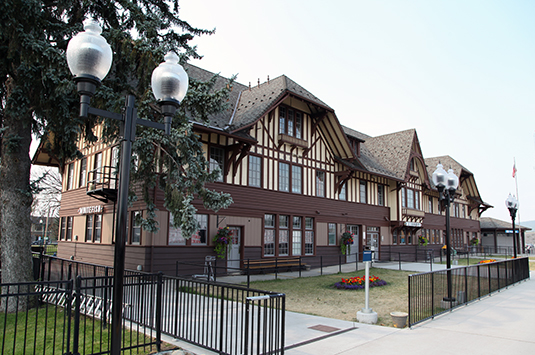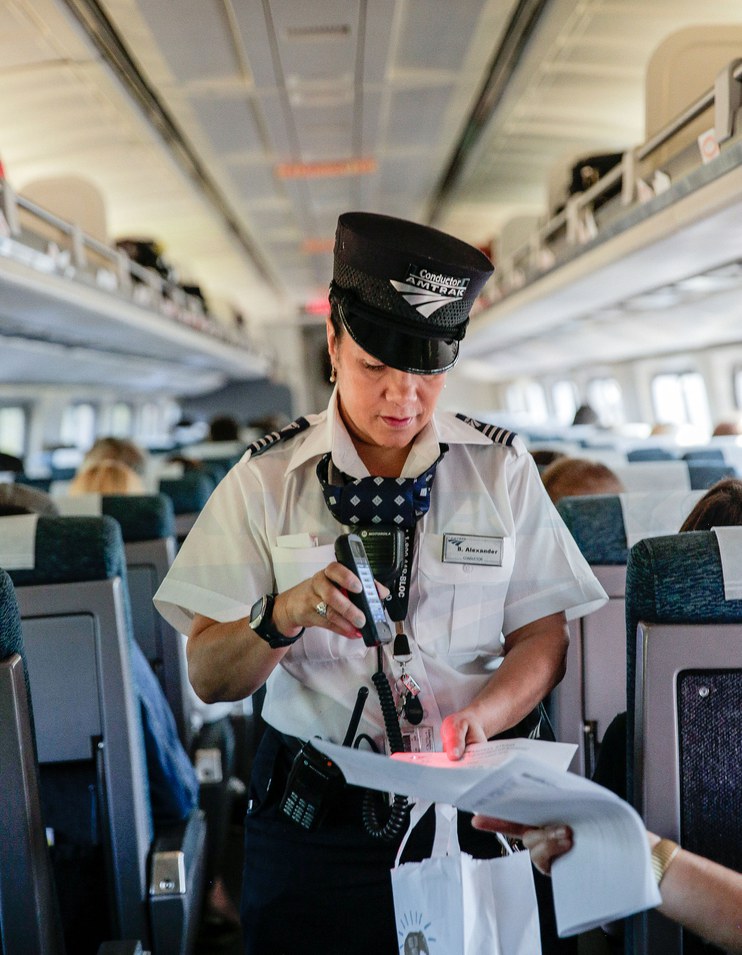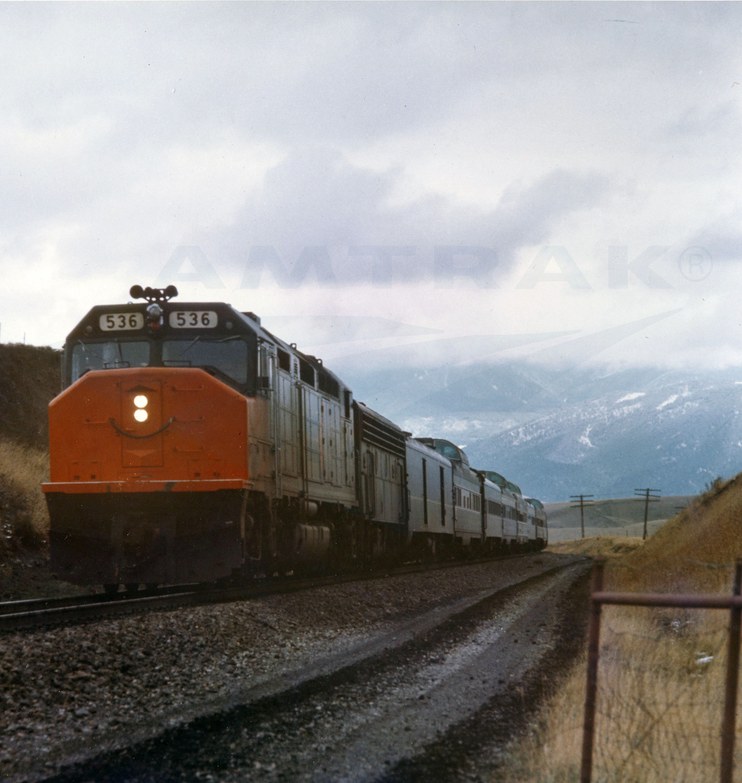Amtrak Voices: Mike Lustig, Part 2
CommentsJuly 29, 2016
Amtrak Voices is an occasional series in which we talk with long-time Amtrak employees to discover what attracted them to the company, recount its early days and explore changes they witnessed in railroading during their careers.
Out West
In a repeat of his boyhood trips on the Empire Builder, Amtrak Ticket Agent Mike Lustig headed west to Montana in May 1980. He first worked in Belton, better known today as West Glacier. Five months later, he moved east to Havre, which is centrally located on the High Line—so called because this important freight and passenger rail line crosses the northern parts of Montana and North Dakota. There he fondly remembers working with Ticket Agent Virginia Mork. “She had hired out with the Great Northern Railway (GN) in 1943 as a telegrapher and would tell me stories of when she sold tickets for them.”

The historic Whitefish, Mont., depot is noted for its half-timbered
walls and large dormers.
After five years in Havre, he moved to Whitefish in September 1985. The community sits on the southern edge of a lake bearing the same name and is a popular destination for winter sports enthusiasts. It is also just west of Glacier National Park, whose lakes, forests, meadows and soaring mountains attract millions of visitors each year.
Lustig was based in the old GN depot built in 1928. Designed in an Alpine style, the building features horizontal wood siding on the first floor and half-timbering on the upper stories. The Stumptown Historical Society, which works to preserve the history of Whitefish and the Flathead Valley, renovated the building in the 1990s. Today it houses BNSF Railway offices, an Amtrak ticket office and waiting area and a museum exploring local history.
"Employees also tended to look out for one another. In the stations, it was for the most part like being family.” - Mike Lustig
From April 2000 through October 2001, Lustig transferred to Shelby, Mont., which sits at the center of a rich farming region known as the "Golden Triangle." The area produces the majority of the state's barley and wheat, as well as almost all of the mustard seed grown in the United States. In addition to working in the ticket office, Lustig spent six months as the crew clerk for the train and engine crew base.
Although his title may have changed over the years, Lustig still refers to himself as a “lead ticket clerk” since “that was what the job was called when I hired on. I liked selling tickets, booking reservations. Employees also tended to look out for one another. In the stations, it was for the most part like being family.” After moving to Montana, Lustig credits Dick Schneider, his then-district supervisor, for valuable mentoring. “Dick guided me through learning the ways of working remote stations, and he was sincere as the day is long, a straight shooter.”
In smaller cities and towns across the country, including Whitefish, the ticket agent is often the face of Amtrak. The depot, usually located downtown, functions as a public space and the centerpiece for local events and festivities. It is also a place of shared memory, figuring prominently in residents’ stories and memories. “Representing Amtrak was a tall order,” recalls Lustig. “Amtrak is important in Whitefish and other small towns because it beats driving or riding the bus and smaller towns don’t always have air service. Amtrak needs to run more national network trains.”
Amtrak made major strides in modernizing its ticketing and reservation system and fare structure in the early 1970s. When Lustig started out in Chicago, he would have used the four-year-old Automated Reservation Ticketing System (ARTS). At its introduction, it had eliminated the need to hand-write ticket reservations, thereby saving time and reducing the risk of lost paperwork. ARTS reached a major milestone when it issued more than one million tickets in August 1978.
Due to growing ridership in the late 1970s, ARTS was at times overwhelmed with calls that then triggered delays and shutdowns. In response, Amtrak developed a new system called ARROW that launched in 1982. ARROW had ten times the computing capacity of its predecessor and restored an optimal two- or three-second response time.
In 2012, Amtrak implemented eTicketing across the entire national network. It allows passengers to print their tickets at their convenience or use a smartphone to show the eTicket to the conductor, thereby resulting in shorter ticket lines at stations, fewer tickets sold onboard trains and a decrease in the number of lost tickets. It also provides Amtrak with accurate real time knowledge of who is on the train, en route reporting of onboard equipment problems and more efficient financial reporting.

Amtrak introduced convenient eTicketing across the national
system in 2012.
As retirement neared in fall 2015, Lustig happily “hand-wrote some [paper] tickets for friends so they could have a souvenir from me. The tickets were used for travel, except for one person who wanted to get the last ticket I ever issued from Whitefish to West Glacier.” He adds, “I wrote a [paper reservation] book ticket for a couple of friends going from Los Angeles to Whitefish in Roomettes. The conductor had never seen a book ticket.”
“Reserving passengers’ travel plans, booking and ticketing were always at the core of a ticket clerk’s job,” Lustig says. “I know the many benefits of eTicketing, but I felt like I wasn’t doing my job when just issuing a passenger a piece of paper!” His comment points to how technology is reshaping passenger railroading and the customer experience. Ticket agents are now referred to as customer service representatives because they inhabit a broader role as ambassadors for Amtrak, ready to assist people in whatever way they can.
Many of Lustig’s best memories center on supportive coworkers, as well as some adventures along the way. His favorite Amtrak memory dates back to spring 1979 when he rode the North Coast Hiawatha (Chicago-Billings-Seattle) from Chicago to Billings, Mont., and back, on his days off:
“There was a conductor named Al who would call us at the Chicago Reservation Sales Office to find out how train 7/17 was due into Midway Station [in Minneapolis-St. Paul]. At the time the North Coast Hiawatha ran tri-weekly and the Empire Builder ran quad-weekly so the Builder was train 7/8 (as it is now) and the North Coast Hiawatha was train 17/18.

North Coast Hiawatha approaching the Bozeman Tunnel.
Anyway, I told Al that I would be riding to Billings and asked if by chance I could get a ride in the cab of the locomotive out of Midway. He said okay and on the day I went west, I met Al for the first time. So I got to ride in the cab from Midway to St. Cloud, Minn.
The engineer’s name was John and the fireman’s name was Tom. Also in the cab was the rear brakeman named Bill. He was in the cab because he had to hand-throw some switches coming out of Midway and on to the Burlington Northern Railroad (BN) main line. Back then the train still went over the Stone Arch Bridge in Minneapolis on its way west.
The North Coast Hiawatha was a descendant of the Northern Pacific Railway (NP) flagship train the North Coast Limited. In those days, the train and engine crews worked for the operating railroad (in this case BN)1. The four people mentioned above hired on with the NP and then worked for BN.
1979 was the year that the Carter administration proposed…cuts to the Amtrak route structure…There were petitions in the Billings depot for people to sign to keep the North Coast Hiawatha on. I grabbed some blanks and had people sign them on the trip back, and when I got to Chicago I had friends and co-workers sign too.
Conductor Al was on the eastbound train again and suggested that I send copies to every congressman and senator in the states that the North Coast Hiawatha served. I did just that! Unfortunately, the North Coast Hiawatha was discontinued that year.”
Asked if he has any advice for young people starting out at Amtrak, or railroading in general, Lustig says, “Stick with it. You can have a long career with one company and get a good retirement. It’s very rare these days that someone will work for the same company their entire employment history.”
Interested in hearing more from long-time Amtrak employees like Mike Lustig? Check out past Amtrak Voices posts.
1 In 1970, the NP merged with the GN, Spokane, Portland and Seattle Railway and the Chicago, Burlington and Quincy Railroad to form the Burlington Northern Railroad.
Amtrak History electronic mail interviews with Mike Lustig took place in fall 2015. All quotes by Lustig are drawn from these interviews.





 Customers enjoy some fresh air as the eastbound Empire Builder stops at Havre, Mont. Image courtesy of Joe Rago.
Customers enjoy some fresh air as the eastbound Empire Builder stops at Havre, Mont. Image courtesy of Joe Rago.
